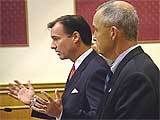Long Island top official calls for investigation of Federal raids.
 Coming on the heels of NY Governor Eliot Spitzer's recent announcement that his state would start making driver's licenses available to its approximately 500,000 undocumented residents in December, a spate of recent Federal immigration raids on Long Island, that infuriated local officials, have drawn the state to the center of the heated national debate on immigration.
Coming on the heels of NY Governor Eliot Spitzer's recent announcement that his state would start making driver's licenses available to its approximately 500,000 undocumented residents in December, a spate of recent Federal immigration raids on Long Island, that infuriated local officials, have drawn the state to the center of the heated national debate on immigration.
The raids, which occurred on September 24 and 26, were characterized at a press conference held yesterday by Nassau County Executive, Tom Suozzi , as poorly structured and executed, leading him to call for a Federal investigation into ICE's handling of the matter.
Click for Video Courtesy News12 LI
Federal agents displayed a "cowboy" mentality while running roughshod over local police officers _ at times pointing their weapons at cops _ and ensnared more suspected illegal aliens than targeted gangsters in raids on Long Island last week, officials said Tuesday.
"There were clear dangers of friendly fire," Nassau County Police Commissioner Lawrence Mulvey said. "We did have members that were actually drawn upon."
Mulvey and County Executive Tom Suozzi want Homeland Security Secretary Michael Chertoff to investigate the tactics used by Immigration and Customs Enforcement agents; ICE is under the jurisdiction of the Homeland Security department.
Newsday
"The Ice official failed on three occasions to check the names and addresses of their arrest suspects against the Naussau County Police Department's Gang Intelligence Files," Suozzi said Tuesday."The result was that many wrong residential addresses were raided, and in one instance, ICE sought a 28-year-old defendant using a photograph taken when the he was seven year old boy.
He stressed that, "Of the reported 82 county arrests, our police records indicate that there are eight active gang members and one is a gang associate."
Suozzi went on to say that “tactically the operation was structured poorly,” and that “some ICE members wore cowboy hats and in the view of some of my members displayed a ‘cowboy’ mentality. This, in my view, posed unnecessary dangers to all parties, including my members, who in fact were drawn upon by the agents."
According to Nassau' Police Commissioner, Lawrence W. Mulvey, officials of Immigration and Customs Enforcement originally claimed they would be executing warrants for residents who were known gang members, but given the final outcome of the raids, he now believes that ICE's initial characterization was "misleading."
Stating that the lack of current intelligence and organization created unnecessary risks to officer safety, Mulvey announced last week that the county would no longer be cooperating with Federal officials on immigration related matters.
Federal agents acted like "cowboys" ... mistakenly pulling their weapons on Nassau Police officers -- during immigration raids in the Nassau County last week, the county police commissioner charged Tuesday.
On two separate occasions during the raids, the federal agents mistakenly aimed their weapons at Nassau County police officers who were serving as backup, Commissioner Lawrence Mulvey said at a news conference with County Executive Thomas Suozzi.
Immigration and Customs Enforcement agents had asked for county police to assist them in arresting gang members on warrants, but the agents appeared to be just rounding up undocumented immigrants, Mulvey said.
However, the special agent in charge of the federal operation, Peter Smith, denied that his agents acted improperly, or that they ever aimed their weapons at Nassau officers.
"We stand behind our operation," Smith said. He said all agents and local officers wore distinctive marking on their vests or shirts, but said "a couple" of agents from other parts of the country might have worn cowboy hats.
Newsday
The Police Commissioner also expressed anger over the damage the raids have done to the departments ability to operate effectively in the immigrant and Latino communities. "This sets us back" with the Latino community, Mulvey said. "We suffer the consequences of the mistrust that develops."
October 2, 2007
Michael Chertoff
Secretary of the Department of Homeland Security
Department of Homeland Security
Washington, D.C. 20536
Dear Mr. Chertoff:
I bring to your attention serious allegations of misconduct and malfeasance committed by Immigration and Customs Enforcement personnel in executing arrest warrants in various Nassau County communities on September 24 and 26, 2007. I ask that you investigate the allegations and advise me of your written findings.
The immigration laws of the United States should be enforced and I fully support the execution of lawfully issued arrest warrants in Nassau County, particularly for known gang members. I condemn, however, any tactical actions which cross the lines of legality and law enforcement best practices.
In order to facilitate an appropriate inquiry, enclosed is a copy of Nassau County Police Commissioner Lawrence W. Mulvey’s September 27, 2007 letter to Joseph A. Palmese, the Resident Agent in Charge of the Immigration and Customs Enforcement (“I.C.E.”) office located in Bohemia, New York. A portion of the letter has been redacted so as not to interfere with planned I.C.E. operations. Commissioner Mulvey’s letter raises important issues as to how I.C.E. personnel, in the presence of Nassau County police officers, conducted themselves, including these observations:
- The operation on Monday lacked current intel.” I.C.E. officials failed on three occasions to check the names and addresses of their arrest targets against the Nassau County Police Department’s Gang Intelligence Files. The result was that many wrong residential addresses were raided and in one instance I.C.E. sought a 28 year old defendant using a photograph taken when he was a 7 year old boy. Of the reported 82 Nassau County arrests, our police records indicate that 8 are active gang members and 1 is a gang associate.
- “Tactically the operation was structured poorly.” The federal operation utilized border patrol personnel from around the country who had not trained together for this complex mission. “[S]ome [I.C.E.] members wore cowboy hats and in the view of some of my members displayed a “cowboy” mentality. This, in my view, posed unnecessary danger to all parties, including my members, who in fact were drawn upon by some of the agents.”
I know you agree that these are serious allegations and deserve a serious and prompt response.
Very truly yours,
Thomas R. Suozzi
County Executive
Cc: Julie Meyers, Assistant Secretary for I.C.E.
Roslynn Maskopf, United States Attorney for the Eastern District
Kathleen Rice, Nassau County District Attorney
Watch video of press conference HERE















 This past week we witnessed the responses of two local law enforcement agencies to increasing political pressure to rely upon them to enforce federal immigration policy:
This past week we witnessed the responses of two local law enforcement agencies to increasing political pressure to rely upon them to enforce federal immigration policy:  When talk turns to immigration and immigration reform more often than not the discussion will revolve around the border states or California with its large Latino population, or even the southeast where the recent influx of new immigrants has sparked backlash and controversy. But rarely do people think of traditional immigrant gateways like New York. Yet, every year New York is in the top three states for the number of foreign born residents both legal and illegal, and as anyone with even a cursory knowledge of the state can figure out, the bulk of those immigrants live in and around the NYC area.
When talk turns to immigration and immigration reform more often than not the discussion will revolve around the border states or California with its large Latino population, or even the southeast where the recent influx of new immigrants has sparked backlash and controversy. But rarely do people think of traditional immigrant gateways like New York. Yet, every year New York is in the top three states for the number of foreign born residents both legal and illegal, and as anyone with even a cursory knowledge of the state can figure out, the bulk of those immigrants live in and around the NYC area.
















